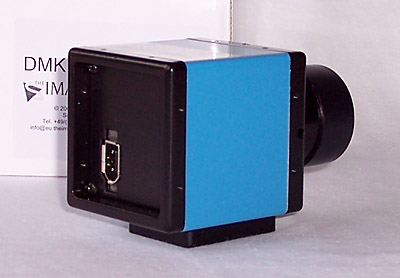Imaging Source DMK 21AF04.AS
Camera review for solar system imaging
Page 2 - DMK 21AF04.AS overview
I've chosen the DMK 21AF04.AS to replace my previous cam since the latter had some severe issues with banding noise patterns in high gain settings.
Lets look at some camera details first:
| Camera model | The ImagingSource DMK 21AF04.AS |
| CCD model | Sony ICX098-BL (1/4" monochrome progressive scan) |
| Pixel size | 5.6µm x 5.6µm square |
| Bus, protocol | IEEE 1394a (Firewire 400MBit/s), IIDC/DCAM 1.31 |
| Max. usable resolution | 640 x 480 pixels |
| Pixel depth | 8 bit output (10 bit internal analog to digital conversion assumed) |
| Frame rates | 60, 30, 15, 7.5, 3.75 fps |
| Integration/exposure times | 1/10000s to 60min |
| ROI (Region of interest) | Yes |
| Binning | No |
| Lens mount | C/CS |
| Built-in filters | No |
| Power supply | 8 V to 30 V DC via 6 pin firewire port (~200 mA @ 12 V) |
| Physical dimensions | Metal housing, 50.6mm x 50.6mm x 50mm, 265g |
 21AF04 with C/CS mount to 1.25" adapter attached |
The compact enclosure of the DMK 21AF04.AS features a C/CS mount on the front. The camera can be adapted to a telescope or telescope equipment by 1.25" or 2" eyepiece adapter, T2 mount adapter or other adapters screwed into the C mount thread of the cam (adapters not included with the camera).
 Back of 21AF04 with 6 pin IEEE1394 connector |
The back of the camera holds a 6 pin IEEE1394/firewire connector jack. The cam can be powered via this connector only. 6 pin firewire interfaces of desktop computers usually power the lines but powered 6 pin connectors can only be found on very few laptop computers (e.g. some models from Samsung & Apple), most mobile machines feature the unpowered small 4 pin connector. Since most astronomers use laptops in the field the camera power has to be applied externally. This can be done by a Y-cable available from ImagingSource (4 pin plus additional power-jack to 6 pin, quite costly, though) or a PCMCIA firewire card with an extra power jack. I prefer the latter solution and power the camera with a lead battery powerstation since this will exclude any noise possibly introduced by a mains adapter. Choosing the correct voltage is totally uncritical since the cam operates between 8V and 30V DC to adapt to all practical scenarios (nominally 25V but can be down to 9V on some laptop ports).
 PCMCIA IEEE1394a interface with external power connector |
The bottom of the camera holds a metal base plate with 3 1/4" UNC tripod screw threads.
 Bottom of 21AF04 - baseplate with 1/4" tripod threads |